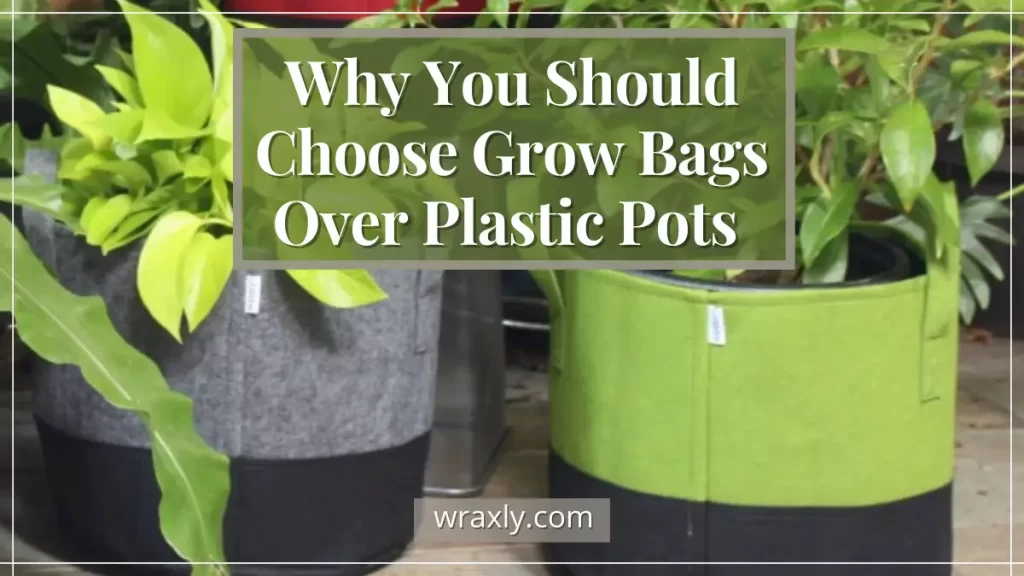Plastic pots, ceramic pots, and terra cotta pots and flowerpots have been used for ages to house our plants, whether it’s to show off seasonal blooms, or cultivate our own tomatoes. But plastic pots crack, and ceramic and terra cotta pots are just one fall from a plant stand away from shattering. Plus, they take up tons of space when trying to store them for the winter.
For those gardeners who are looking for something better, fabric grow bags are a popular new alternative. Both lightweight and durable and with secure handles for easy moving, they make container gardening a breeze!
Whether you want them indoors for your houseplants, or stacked into a vertical garden on your balcony, they may just be the flowerpot alternative you’ve been looking for.
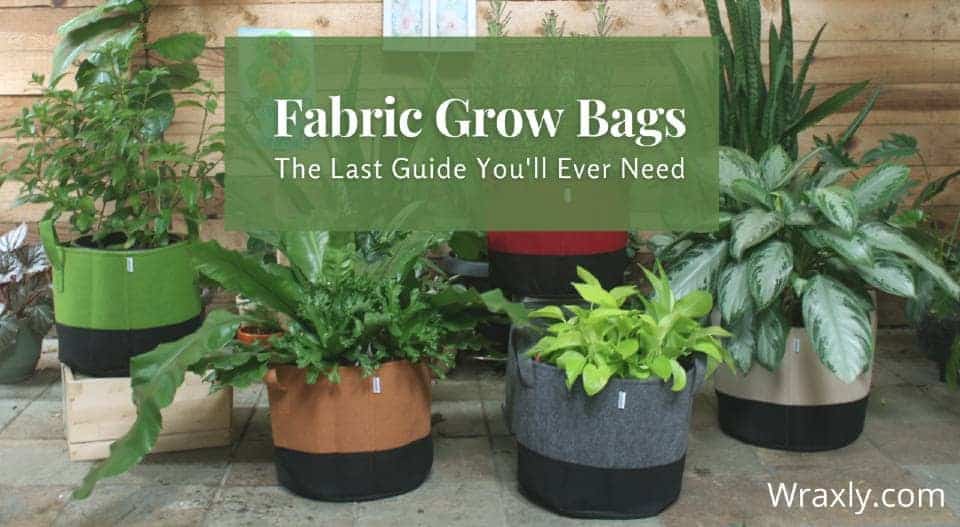
- HERE'S OUR TOP PICKS…
- Advantages of fabric grow bags
- Fabric grow bags vs. plastic pots
- How long do fabric grow bags last?
- What are fabric grow bags made of?
- Are fabric grow bags safe for my plants and the environment?
- How to use fabric grow bags
- Soil for fabric grow bags
- What kind of plants can be grown in a fabric grow bag?
- Can you reuse fabric grow bags?
- Do fabric grow bags need drainage holes?
- What size grow bag for vegetables
- Pros and cons of grow bags
- How to clean fabric grow bags
HERE’S OUR TOP PICKS…
| Image | Title | Prime | Buy |
|---|---|---|---|
 Top
Top
Top
Top
Top
Top
Top
Top | Gardzen 10-Pack 5 Gallon Grow Bags, Aeration Fabric Pots with Handles | PrimeEligible | Check Price on Amazon |
Top | Wraxly Fabric Grow Bags - 7 Gallon Colorful Two-Tone Planter Pots. Best Gardening Gift for Plant Lovers! [5-Pack of Assorted Colors - Plus Black Bonus Bag!] | PrimeEligible | Check My Price on Amazon |
 Top
Top
Top
Top
Top
Top
Top
Top | VIVOSUN 10-Pack 15 Gallon Grow Bag, Reinforced Planter Fabric Pot for Gardening | PrimeEligible | Check Price on Amazon |
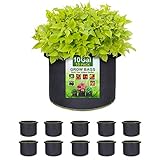 Top
Top
Top
Top
Top
Top
Top
Top | SunArea 10-Pack 10 Gallon Grow Bags, Thickened Nonwoven Aeration Fabric Pots with Reinforced Handles, Heavy Duty Plant Grow Bag for Gardening | PrimeEligible | Check Price on Amazon |
 Top
Top | VIVOSUN 5-Pack 20 Gallon Plant Grow Bags, Heavy Duty Thickened Nonwoven Fabric Pots with Handles | PrimeEligible | Check Price on Amazon |
 Top
Top | JERIA 12-Pack 5 Gallon, Vegetable/Flower/Plant Grow Bags, Aeration Fabric Pots with Handles (Black), Come with 12 Pcs Plant Labels | PrimeEligible | Check Price on Amazon |
Advantages of fabric grow bags
Let’s start by thinking about all the reasons we love flowerpots: they’re portable, compact, reusable, and you don’t have people or animals walking through them like you would a regular flower bed. You get all these benefits and more with a fabric grow bag!
Healthier roots
In a typical pot, roots grow until they hit the wall. At that point they make a sharp turn and continue growing alongside the wall of the pot, searching for water and nutrients. This eventually causes the roots to encircle each other and tangle, causing them to take in less water and nutrients. Eventually, this causes structural damage throughout the entire plant as the problem continues to make itself worse.
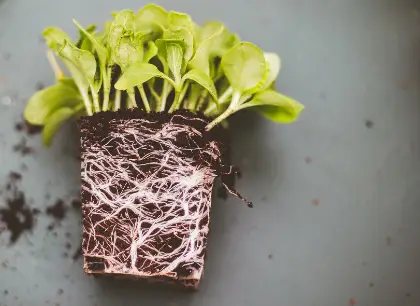
With grow bags, the root senses the drier soil that is exposed to the air as it approaches the wall. This signals to the plant that it’s reached its growing limit. The root then prunes itself in a process called “air pruning,” and begins growing more fibrous roots from the main root. This helps the plant take in even more nutrients. This is a much healthier root system and leads to a sustainable and healthy plant.
Temperature control
The unique material of a fabric grow bag is universally breathable, allowing air to flow in and cool the soil. This means plants planted in grow bags can self-regulate their own temperatures, preventing them from getting cooked in the hot sun.
Efficient Drainage
Just as the breathable fabric of a grow bag allows air in, it lets water out. Excess water naturally drains from the sides and bottom of the bag, preventing your plant from drowning.
Nutrient Conservation
When plants are rooted next to each other in a typical garden bed, their roots can fan out and steal nutrients from each other. With fabric grow bags, they each get to use their own nutrients without their neighbors stealing from them.
Versatility for any Garden Size or Shape
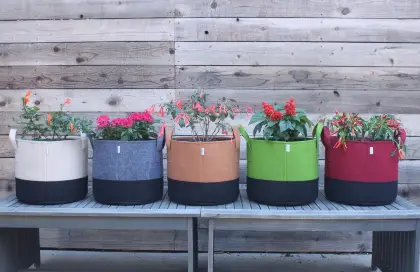
Fabric grow bags are excellent for planting in small spaces. This allows for denser planting, without forcing your plants to compete for nutrients. They can even be stacked or hung to create vertical gardens, a unique way of gardening with limited space! If you do have the space for a garden bed, you can even use fabric bags here, as well. Since they are breathable and eco-friendly, they can actually be planted straight into the ground.
Easily portable
Fabric grow bags are a hit with RV-ers. Why? With a typical pot, you have to secure it from falling over and breaking while on the road. Then you need to lug the heavy ceramic pot outside to enjoy it when you’ve gotten where you’re going. Fabric grow bags don’t run the risk of tipping over and shattering. Plus, with their lightweight and durable handles, they’re easy to grab and move.
Fabric grow bags vs. plastic pots
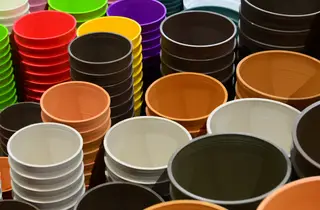
Plastic and ceramic pots trap heat and water and can eventually cause root and stem damage. Fabric grow bags, on the other hand, are universally breathable. This means they regulate their own temperatures, which prevents your plants from getting fried in the hot sun. Also, they naturally allow excess water to drain through the fabric. You can practically hear your plants sighing in relief!
Additionally, pots cause unhealthy root circling, whereas fabric grow bags promote healthy root systems. Need to move your plants? Fabric grow bags are lightweight with durable handles, as compared to heavy, clunky flowerpots.
How long do fabric grow bags last?
You may be surprised by this one — a fabric grow bag, when cleaned and stored properly between growing seasons, can last up to 10 years or more!
Since the fabric is made of pressed-together fibers, rather than woven, they are much more durable than, say, a burlap grow bag. Additionally, their sturdy sides and handles make them much easier to work with. They’re more resistant to the elements, and don’t readily biodegrade like other materials. So take care of those bags like you take care of your plants, and they’ll serve you well for years to come!
What are fabric grow bags made of?
You’ve probably found yourself wondering what fabric grow bag material is made of. With all this hype, surely this has to be the fabric of the gods, right?
Well, that might be a bit of a stretch — but the material is definitely the key to the grow bag’s success. Rather than being sewn from traditional woven fabric, they are constructed using a non-woven material such as felt. Felt is a fabric that is pressed, rather than woven, together. Felt is more breathable than a typical pot. This allows your plants’ roots to breath, and it also does a great job of regulating the soil’s temperature.
Are fabric grow bags safe for my plants and the environment?
Fabric grow bags are one of the healthiest ways you can grow plants in your backyard, for both your plants’ and the environments’ sakes.
The felt fabric’s breathability helps your plants create incredibly healthy root systems as compared to regular pots. Plus, because the fabric is porous, it also prevents your plants from drowning or getting fried on a hot day. As the oldest fabric known to man, felt has been proving its sustainability and quality over the last 5,000 years.
How to use fabric grow bags
Buy your fabric grow bag
You can find grow bags in 1, 2, 3, 5, 7, 10, 15, and 20 gallon sizes. They can even be found as large as 200 gallons! The size you choose depends upon what you want to grow.
Choose your soil
Local, organic soil can be purchased from a nearby gardening or landscaping store. Specific soil types will depend on what you’re trying to grow, but most plants will thrive in a Loam Soil. Be sure to add compost — if you don’t make your own compost, you can purchase this as well. Make sure you include a 1-2-inch layer of Perlite or rough gravel at the bottom of the bag. This will let the soil completely drain and avoid mold.
Plant your plant
You can plant your plants just as you would in a normal pot or garden bed. If transplanting a grown plant with an established root system, gently and slightly separate the roots before placing in the hole. Surround the plant with enough soil to cover the roots, but not choke the plant. Next, lightly pat down the soil, and water to help the plant establish itself.
Position your grow bag
This is the fun part- deciding where you’re going to place your grow bags! Find a place that meets your plants’ sun or shade requirements, and position how you like. Whether you’re setting them out decoratively, hanging them vertically, or planting them in a bed, they’ll be sure to thrive.
Tend to your plant throughout the growing season
Again, tending to your plant in a fabric grow bag is fairly similar to regular garden maintenance. Try to allow the bottom third of the bag to mostly dry out before re-watering. It’s possible for mold to occur when the bag is staying constantly wet. This is where the Perlite or gravel plays its role. You may need to take some weed or pest precautions or mitigation measures. You can also position companion plants together when using fabric grow bags, which can help keep pests at bay.
Replant or empty and store
If you have a perennial plant in your fabric grow bags, then all you need to do is decide if they can winter outdoors or need to be brought indoors. For annuals, you can remove the dead plant, or choose to let it decompose in the fabric bag and give its nutrients back to the soil. If you’re removing everything, make sure to wash your bag and let it dry. Then you can fold it up and tuck it away in storage until the next season. Instructions on washing your bags are further down.
Repeat!
For those bags you stowed away at the end of last season, get ready to pull them back out and repot! For bags still containing perennials, refresh the soil nutrients with some new compost. Alternatively, you may have decided to repot at the end of the summer season with a winter plant, or move it indoors to plant a houseplant. If you wish to plant something new in one of these bags, remove the old plant or mix it into the soil for nutrients, add a little compost, and repeat the planting process. Happy growing!
Soil for fabric grow bags
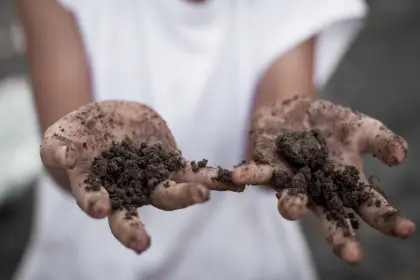
You will need to pay special attention to the type of soil you use in your pots.
Most importantly, you must start with a 1-2-inch layer of Perlite, a porous mineral found in volcanic material. You’ve probably seen Perlite before without realizing it: it’s those small, white, round balls that are often intermixed with commercial potting soils. Since it’s so porous it allows water that normally would gather towards the bottom to drain, preventing mold on fabric grow bags.
Alternatively, if you don’t have Perlite, you can use rough gravel at the bottom.
You can fill the rest of your pot with Loam soil, which is an even blend of silt, sand, and clay, mixed with organic compost, for nutrients. The general rule is: once you’ve established the Perlite/gravel in the bottom, continue with the same soil you would for your plant in any other pot (with compost, of course!).
Learn more about picking the right soil for fabric grow bags.
What kind of plants can be grown in a fabric grow bag?
As a rule, any plant that can be planted in a flowerpot can also be planted in a grow bag.
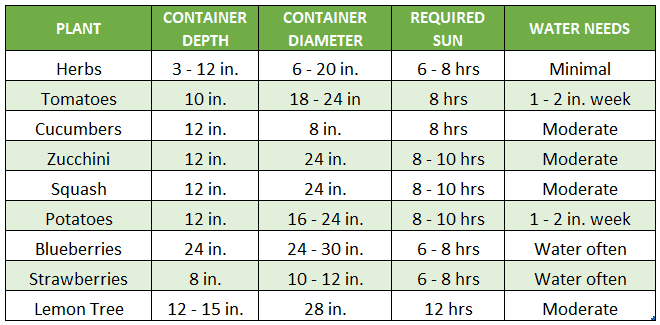
But they are also a great way to plant vegetables or herbs! You can insert a trellis into your grow bag soil for viney plants such as tomatoes, trumpet vines, or wisteria. You can even interplant clover or another cover plant with your flowers or vegetables in the grow bag. This will help keep weeds away.
Some gardeners decide to plant their entire vegetable garden bag by bag! It’s a great way to save space and nutrients.
If you’ve ever been to the tree section of a nursery, you’ve probably seen saplings in fabric grow bags. These are normally used just to grow and house saplings until they’re taken home and planted in the ground. However, you can also use fabric grow bags for trees that you would normally put in a pot! Just keep in mind, the smaller the fabric bag they are planted in, the smaller they will remain. Plan your tree size accordingly.
Can you reuse fabric grow bags?
Yes! Fabric grow bags are great for the conscious gardener. They don’t crack over time like plastic pots, or shatter if, say, your pesky cat knocks one off the patio. When you’re ready to replant a grow bag, simply remove your old plant, replenish the soil nutrients with a little compost, and plant your new addition! If you’re not using all of your grow bags one season, you can just fold up the extras and store them along with the rest of your gardening supplies.
Do fabric grow bags need drainage holes?
Nope! The bags are made of felt, which means they’re covered with micro drainage holes. This means that excess water seeps out of the bag, and outside air can penetrate the soil, keeping your plants from drowning. Fabric grow bags drainage systems are self-sustaining and require no maintenance- all you have to do is water!
What size grow bag for vegetables
Most above-ground vegetables will thrive in a typical 7-gallon bag. Many people start out using fabric grow bags for tomatoes, then end up using them for all their veggies! Peppers, zucchinis, cucumbers, eggplants, squash, onions, and salad greens are all common vegetables to grow well in a typical 7-gallon bag. Tomatoes and potatoes can also be grown in 7-gallon bags, but will do better in a 10-gallon, where they have more space in the soil to grow. 3-gallon bags are perfect for growing herbs or tea plants.
Pros and cons of grow bags
The pros are pretty overwhelming here:
- good drainage
- temperature control
- lightweight and durable
- easily portable
- they’re reusable
- can last for years
- allow your plants to have healthier root systems than a regular pot
- they allow you to maximize your plant growth with limited space
Pretty much the only con is when the water that drains through the fabric collects in the saucer. If the bag sits in the stagnate water, it can lead to mold and root rot. Luckily, this is preventable. Just elevate them off the ground to allow the water to drain away from the bag. You can do this by placing them on some rocks or bricks, or purchase elevated plant trays. Here at Wraxly Central, we use these Square Farmer pot elevators:
- 2-in-1 garden saucer and plant riser
Prices pulled from the Amazon Product Advertising API on:
Product prices and availability are accurate as of the date/time indicated and are subject to change. Any price and availability information displayed on [relevant Amazon Site(s), as applicable] at the time of purchase will apply to the purchase of this product.
How to clean fabric grow bags
A new consideration that those who have always used pots or beds is how to wash fabric grow bags. When it comes to cleaning out a bag, you can really go as in-depth as you want. Some gardeners simply empty out the soil and give the bag a good shake before storing them away for the winter. Others will give them a rinse with the hose and let them air dry.
If you want to go all the way spotless, either for principle, or because you want to use your grow bag to store something else, such as toys or fresh produce, then check out our cleaning recommendations.
Go ahead and give those fabric grow bags a shot. If you truly aren’t happy with portable, nutrient-rich plants with their healthy roots, then just give the bag a wash, and use it for storage. You can’t lose!

Darrell has a passion for gardening that he inherited from his father. Go here to read more about the influence his father played in his love for gardening. If you want to send Darrell a quick message, then visit his contact page here.
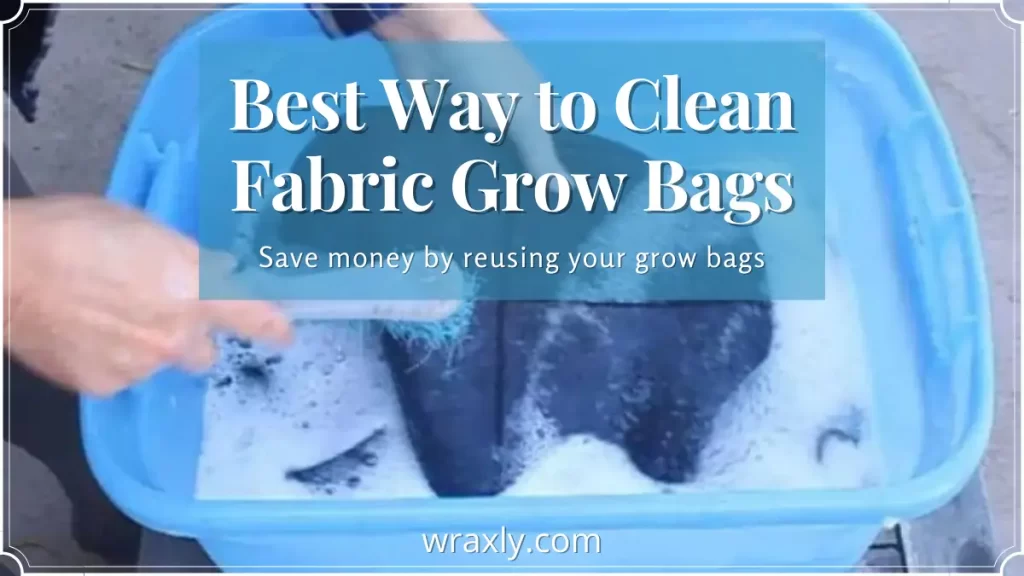
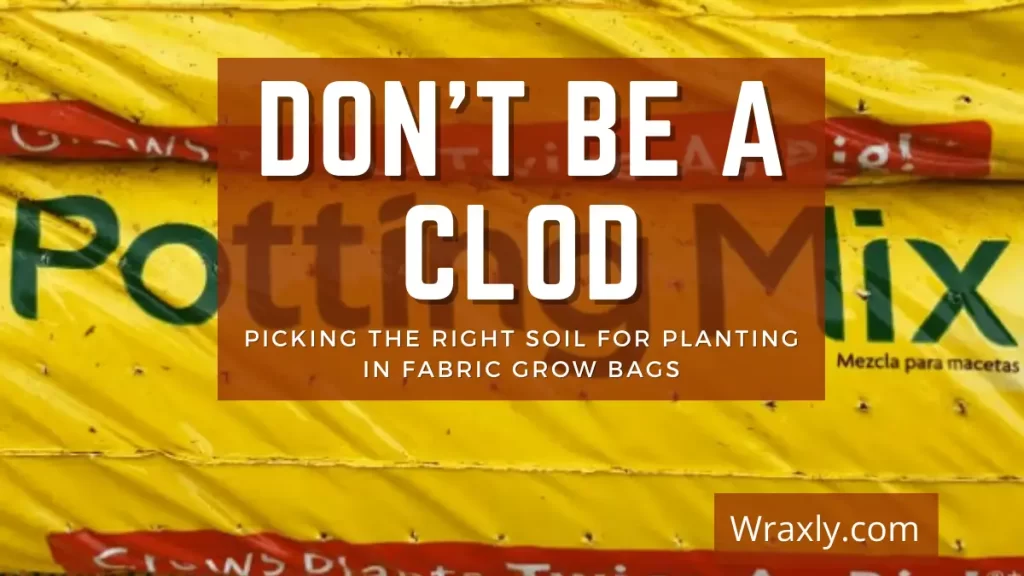
![Container gardening for beginners [Buying guide]](https://wraxly.com/wp-content/uploads/2021/02/Container-gardening-for-beginners-Buying-guide-1200-1024x576.webp)
